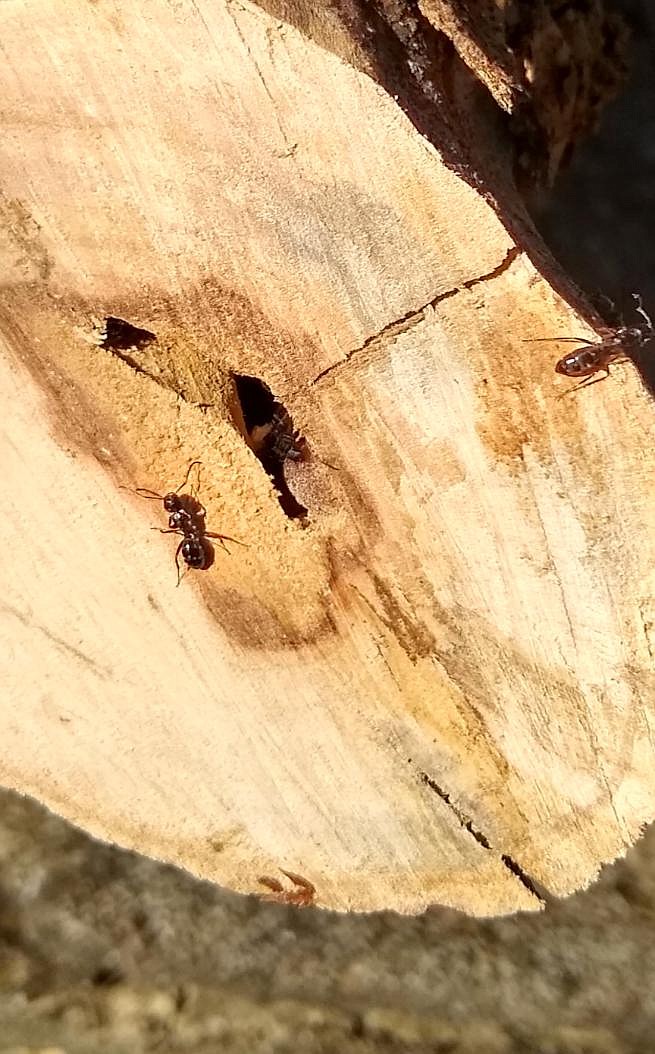Q. I was asked to cut off a couple of dead branches from a Japanese maple. When I cut one, the center was hollow and there were black critters inside. They look like big black ants. I’m trying to get them identified to see what they are and what we can do to prevent them. (see photo)
A. Never fear … those ants are likely doing more good than anything. Carpenter ants get their name from their habit of building nests in wood. Unlike termites, they do not feed upon wood but merely use it as a place to nest. Carpenter ants normally construct their nests in hollow trees, logs, posts and landscaping timbers. They prefer to nest in wood that is moist and rotting or has been hollowed out by decay or by other wood-destroying organisms. Determining why the tree is rotting is important and doing what one can to see it stays healthy is most important. These ants may help keep the moist/rot to be less. We do have guidance on how to kill them, but oriented toward if they are in a structure of some kind.
The greatest concern with carpenter ants is that they will establish satellite nests in structural wood. This can cause serious damage. They will establish these nests in areas such as the roof trim, siding, rafters, joists, sheathing, decks, porches, steps, sills, subflooring, doors and window frames. Therefore, if the tree is close to a structure, then eliminating them would be a good idea.
Q. I have heard about no till vegetable gardening and was considering it. Can you tell a bit about it and some pros and cons?
A. That concept is making the rounds in a lot of gardening magazines and similar publications. We don’t have much information about it at the Extension, but I am somewhat familiar with it.
I’ll first deal with the negatives, and for many individuals who may eliminate any thoughts of trying it. First, if your vegetable garden is anywhere near enough woody bushes or trees, that their roots will invade that area, not a good idea. Annual tillage to break up those woody plant roots is imperative or else you’ll end up just watering and fertilizing them. Second, having bare black soil in the early spring will help the soil to warm more quickly. No till usually has mulch covering the soil, and this will suppress the warming of soil temperatures during that critical period of early to mid-spring.
Now for the pros, by not tilling, it can save on some backbreaking work and it retains nutrients/improves soil quality over time. One uses a lot of mulch to suppress weeds, and different folks use different approaches for this. Some like to put down cardboard or newspaper and mulch onto of that. Others like to make a very thick layer of mulch. One does have to pull back the mulch to transplant or seed into the soil, so it’s not like you “never till,” more like you do it very minimally. Check for more information on this if interested; this just touches on the subject.
Right now is a good time to consider this if interested. That is because one can “smother” an area under consideration. If left that way for three to four months (December through March), by April, all the plants underneath should have died out. Smothering can use cardboard with mulch on top or a black plastic or similar (held securely in place). It is very important that whatever is used, it completely blocks out the sunlight.
Deer alert!
Bucks are now actively rubbing their antlers on trees to remove the dried velvet from their antlers and to mark their territory. If you are in an area that is new to deer, watch out, especially for small/newly planted trees!
This rubbing removes the thin layer of bark on small trees and can seriously damage or destroy them. Trunk damage typically occurs 1½-3½ feet above the ground. Damage caused by bucks rubbing their antlers on small trees can be prevented by driving three sturdy wooden stakes or fence posts around each tree in late summer. Space the stakes or posts about 18 inches apart.
Protect trees already damaged and repair as best possible. Shredded bark should be trimmed/cleaned up as best possible. If the bark is freshly damaged and in large enough strips, one can tape it tightly back onto the trunk. Sometimes that living layer can recover.

